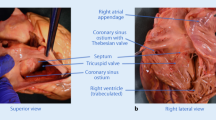Abstract
Purpose
To assess the use of percutaneous endovascular stent insertion in the management of superior vena cava (SVC) occlusion.
Methods
Percutaneous endovascular stent insertion was attempted in 13 patients, age range 20–72 (mean 55.5) years, with symptomatic total occlusion of the SVC. Twelve patients had known malignant disease of the thorax. The other patient (age 20) had chronic SVC obstruction, the cause of which was unknown at the time of the procedure. There was initial angiographic assessment and removal of thrombus by thrombolysis (10 patients) and/or clot aspiration (3 patients). Following successful lysis or aspiration, single or multiple endovascular stents were inserted.
Results
The inability to cross the lesion with a guidewire prevented stent insertion in 2 patients (15.4%). There was primary success in the remaining 11 patients (84.6%), with associated symptomatic relief. Some recurrence of symptoms occurred in 5 of the 11 patients (45.5%) after a time interval ranging from 14 to 183 days. In all cases of symptomatic recurrence, patency was reestablished with further thrombolysis and/or further stent insertion. All successfully treated patients have since died. All 11 patients remained symptomatically free of SVC occlusion until death, with postprocedure survival ranging from 5 to 243 days.
Conclusion
The percutaneous management of complete SVC occlusion with thrombolysis and/or clot aspiration followed by stent insertion is safe and effective, giving sustained symptomatic relief.
Similar content being viewed by others
References
Perez CA, Presant CA, Van Amburg AL III (1978) Management of superior vena cava syndrome. Semin Oncol 5(2):123–134
Irving D, Dondelinger R, Reidy J, Schild H, Dick R, Adam A, Maynar M, Zollikofer C (1992) Gianturco self-expanding stents: Clinical experience in the vena cava and large veins. Cardiovasc Intervent Radiol 15:328–333
Rösch J, Uchida B, Hall L, Antovic R, Peterson B, Ivancev K, Barton R, Keller F (1992) Gianturco-Rösch expandable Z-stents in the treatment of superior vena cava syndrome. Cardiovasc Intervent Radiol 15:319–327
Gaines P, Belli A, Anderson B, McBride K, Hemingway A (1994) Superior vena caval obstruction managed by Gianturco Z stent. Clin Radiol 49:202–208
Charnsangavej C, Carrasco C, Wallace S, Wright K, Ogawa K, Richli W, Gianturco C (1986) Stenosis of the vena cava: Preliminary assessment of treatment with expandable metallic stents. Radiology 161:295–298
Rösch J, Bedell J, Putnam J, Antonovic R, Uchida B (1987) Gianturco expandable wire stents in the treatment of superior vena cava syndrome recurring after maximum-tolerance radiation. Cancer 60:1243–1246
Kishi K, Sonomura T, Mitsuzane K, Nishida N, Yang R, Sato M, Yamada R, Shirai S, Kobayashi H (1993) Self-expandable metallic stent therapy for superior vena cava syndrome: Clinical observations. Radiology 189:531–535
Author information
Authors and Affiliations
Rights and permissions
About this article
Cite this article
Crowe, M.T.I., Davies, C.H. & Gaines, P.A. Percutaneous management of superior vena cava occlusions. Cardiovasc Intervent Radiol 18, 367–372 (1995). https://doi.org/10.1007/BF00338303
Issue Date:
DOI: https://doi.org/10.1007/BF00338303




